Table of Contents[Hide][Show]
How to make homemade ghee on the stovetop quickly and easily for a healthy cooking fat that is shelf stable and nourishing.
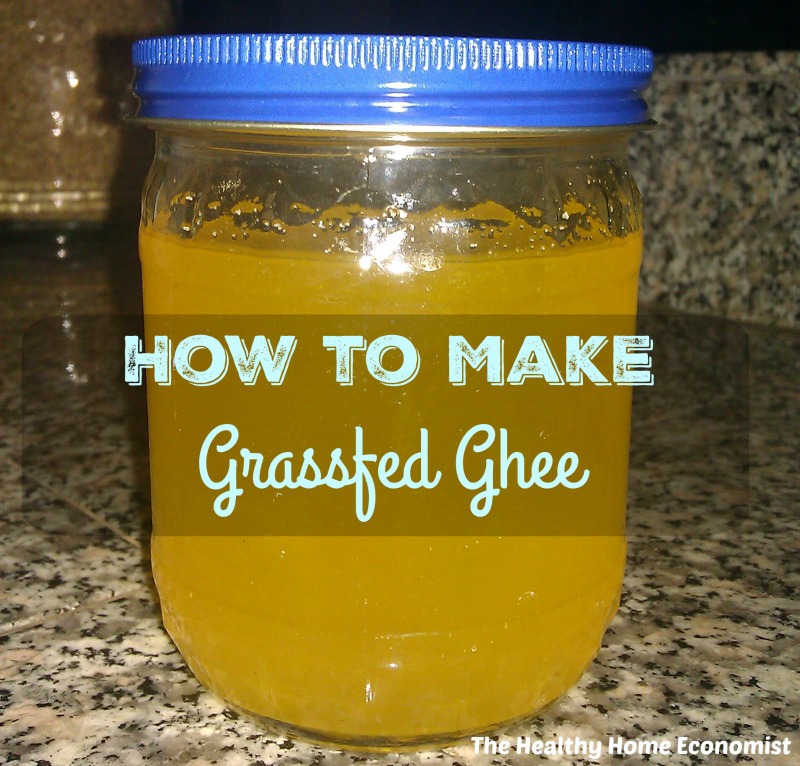
Knowing how to make ghee is simply a must for any Traditional Cook. Clarified butter as it is also known, has been used for thousands of years by Indian cultures. In fact, traces of ghee have been found on fragments of Indian pottery dating as far back as 6500 BC!
When in a liquid state and made from unheated butter, ghee is called butter oil. Dr. Weston A. Price discovered that butter oil and cod liver oil work synergistically to supercharge absorption of Vitamins A, D, and K2 known as the X-factor.
Dr. Price always carried flasks of cod liver oil and butter oil to the bedside of very ill patients. More often than not, he was able to revive them with a few drops of each under the tongue. Using cod liver oil or butter oil separately did not have the same deathbed reviving effects.
Benefits of Ghee over Other Cooking Fats
It is best to know how to make clarified butter oil or ghee yourself rather than buying from the store. Notice the picture above of a jar that I made myself with pastured butter from a local farm. It is so yellow!
Commercial ghee from the store is a pale yellow, indicating lower nutritional value from cows eating grain mix instead of fresh green grass.
Ghee from the store is also ridiculously expensive, so learning to make it yourself is not only a more nutritious way to go, it is very cost-effective.
I make clarified butter oil for about half the cost of what it would be to buy it at the health food store.
Unlike butter, ghee does not need refrigeration and keeps well on the counter or pantry for many months. Keeping a jar in the pantry for a quick veggie saute is very convenient!
Another benefit of ghee is that it is easier to digest as all the milk solids (proteins) have been removed from the butter. Very frequently, even those with a true dairy allergy find that ghee presents no trouble for them.
Another advantage to using clarified butter instead of plain grass-fed butter is that the grassy taste and sometimes cheesy smell of the butter is eliminated.
Therefore, by learning to make clarified butter oil from grass-fed butter, you will find that you now have a healthy fat for cooking that does not displease your family with a cheesy odor. This can sometimes happen with grass-fed butter alone.
Homemade Grass-Fed Ghee
The recipe and video lesson below covers how to make this healthy and indispensable fat for use in your own kitchen.
I also cover how to make clarified butter capsules. This is a convenient way to take butter oil with your daily dose of cod liver oil.
If you are spending money on high vitamin cod liver oil (this is the brand I’ve used since 2015) it is a must to be taking it with clarified butter oil. This supercharges the beneficial effects!
Note that it is not advisable to make ghee from homemade raw butter. The heating process causes a loss of the enzyme and probiotics in this special food.
Prefer to Buy?
If after reviewing the recipe and video demo below you decide to buy instead, I would recommend this vetted source as a premier retailer of quality grass-fed ghee. Plain, cultured, and herb-flavored varieties are all available including a coconut oil/ghee blend.
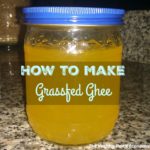
How to Make Ghee
This simple recipe for making ghee can be accomplished on the stovetop in just a few minutes.
Ingredients
- 1 lb butter preferably grassfed and organic
- 1 wide mouthed mason jar quart size
- 1 cheesecloth fine mesh
- 1 funnel
Instructions
-
Place pound of butter in a medium sized pot or stove safe glass bowl. Turn heat on low and allow the butter to gently liquefy.
-
Turn heat to medium-low and gently remove foam that comes to the top of the melted butter with a slotted spoon.
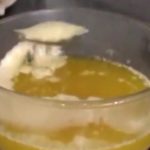
-
After removing the foam, allow the melted butter to simmer on medium-low heat for 5-10 minutes longer to allow all the milk solids to settle out on the bottom of the bowl. You will know when the separation process is complete as the solids will be slightly brown on the bottom and the clarified butter will be completely clear and transparent.
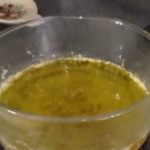
-
Line a funnel placed into the open end of a wide mouthed mason jar with a fine mesh cheesecloth.
-
Pour the clarified butter into the funnel so that it is strained through the cheesecloth as it enters the mason jar.
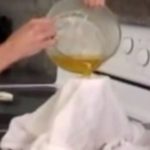
-
Allow the finished ghee to cool in the mason jar. When room temperature, fasten the lid on tightly and store in the pantry as a convenient and incredibly healthy cooking oil for all your kitchen needs.








I tried this, but mine definitely came out more brown than yours looks in the picture- Was I supposed to be using a glass pot, or is there some other reason that mine is darker?
That sounds like what happened to mine. I used a stainless steel pan.
I tried this today and when I poured it into my jar, it didn’t seem clear enough. I heated it longer… And now it’s darker and even less clear. I think I messed it up… Maybe burnt the butter? Is that even possible over low to medium heat? Suggestions for next time? Thanks!
So excited to know how to make ghee!
I heard that KerryGold is a good brand for butter (I think it is low temp pasteurized, do you know?). And if this is a good brand, should I also stock up on it now? (Not sure if it is springtime in Ireland.)
I don’t think an international brand like Kerry Gold would have a seasonal variation like a small farm would. Just a guess.
Hi,
I am trying to store my frozen bone broths in glass in order to prevent the food from interacting with plastic. I just threw out my third mason-type canning jar today because I guess I left it on the counter too long while doing other things and it cracked outside of the freezer. I generally try to thaw them in the refrigerator.
Two large ones cracked in the freezer – the first I thought I had simply overfilled. Then another one cracked which was not overfilled. I have used square pyrex dishes which have plastic tops which do not crack, but they spill so easily I end up wasting a bunch. Any suggestions?
Melinda, if you are going to freeze liquid in a glass jar, you need to use a jar that is designed just for that. Ball makes pint sized canning jars that are smaller on the base and taper up to a larger diameter on top, without the “shoulder” on a typical jar. Otherwise the liquid will freeze, expand and break the jar.
So do you personally use raw butter or do you use pasteurized? And if so, from where?
Thanks for the video! I had no idea I could make it so easily!!!
Hi Amber, I use raw butter for spreading on toast and the like (non-cooking uses) and low temp pasteurized grassfed butter for making ghee.
Sarah, what brand and where do you get the low temp pasturized grassfed butter? I also live in the Tampa area.
Thanks, this looks easy! And now that I’ve found a good source of grass fed butter, I’m looking forward to making it. It is also good to know that I don’t have to fight to find room for it in the fridge (not that there’s all that much more room on my counter tops). Just curious, though… when refrigerated does it remain a liquid, or does it solidify?
It will be useful for culinary experiments in Indian food as well as the nutritional aspects, I’m sure.
Hi Diann, it really depends on the temperature of your home. Our home is about 70F right now (the spring weather is warm already here in FL) and the ghee is soft and easy to scoop out but not liquid. By the time the really warm weather arrives, it will likely stay liquid.
Sarah,
Thank you for all of your wonderful videos. I was curious about the coconut ghee and did some googling. This site mentioned that raising the heat to turn clarified butter into ghee actually improves the flavor and generates antioxidant compounds. Keep teaching us how to be healthy!
Ann
Hi Ann, ghee definitely has improved flavor over regular grassfed butter .. there is no doubt about that ! 🙂 Didn’t know about the antioxidant compounds that are generated! No wonder traditional Indian cultures have stuck with it for so many thousands of years!
Thank you for this video I will be making ghee this weekend. Just wondering what is coconut ghee as compared to coconut oil and why use it?
Hi Lara, the coconut ghee is a special product offered by Green Pasture Products that I have not seen anywhere else. It combines organic virgin coconut oil (75%) with ghee (25%) in a really delightful mix that is a lovely cooking oil.
Can you can the Ghee for long time storage?
I wouldn’t can it. I would freeze it instead.
What is everyone’s favorite FCLO and how do you get it down??
Also, this might be a dumb question… But, how do you find good quality grass fed butter?? Do you just call around and talk to local farmers??